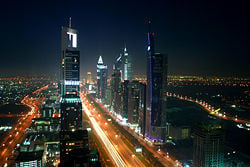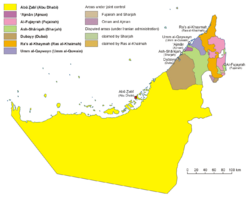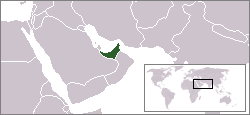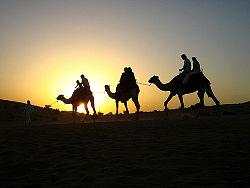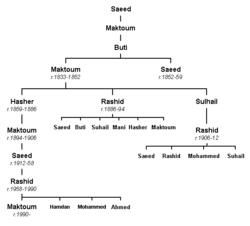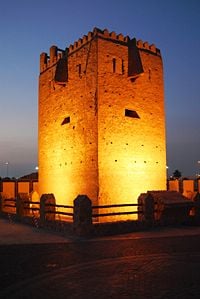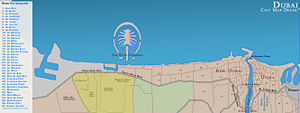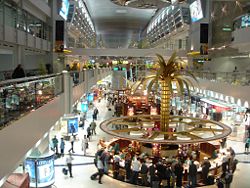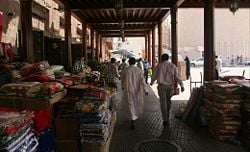Dubai
| Emirate of Dubai إمارة دبيّ |
|||
| Dubai city's nighttime skyline | |||
|
|||
| Coordinates: 25°16′N 55°20′E | |||
|---|---|---|---|
| Emirate | Dubai | ||
| Government | |||
| - Emir | Sheikh Mohammed bin Rashid Al Maktoum | ||
| Area [1] | |||
| - Metro | 4,114 km² (1,588.4 sq mi) | ||
| Population (2006)[2][3] | |||
| - Density | 345.65/km² (895.2/sq mi) | ||
| - Metro | 1,492,000 | ||
| Time zone | Dubai Standard Time (UTC+4) | ||
| Website: Dubai Emirate Dubai Municipality | |||
Dubai (in Arabic: دبيّ, Dubayy, /dʊ'baɪ/ in English)
is one of the seven emirates that constitute the United Arab Emirates (UAE) in the eastern Arabian Peninsula. "Dubai" also refers to that emirate's main city, which is often called "Dubai City" to distinguish it from the emirate. Over 90 percent of the emirate's population resides within Dubai City.
The modern emirate of Dubai was created with the formation of the United Arab Emirates in 1971. However, written accounts documenting the existence of the city have existed at least 150 years prior to the formation of the UAE. Dubai shares legal, political, military, and economic functions with the other emirates within a federal framework, although each emirate has jurisdiction over some functions such as civic law enforcement and provision and upkeep of local facilities.
Dubai has the largest population and is the second largest emirate by area, after Abu Dhabi. It is known as the most modern and progressive emirate in the UAE. With Abu Dhabi, it is one of only two emirates to possess veto power over critical matters of national importance in the UAE. Dubai has been ruled by the Al Maktoum dynasty since 1833. The emirates' current ruler, Mohammed bin Rashid Al Maktoum, is also the Prime Minister and Vice President of the UAE.
Dubai has attracted world-wide attention through innovative real estate projects and sports events. This increased attention, coinciding with its emergence as a world business hub, has also highlighted human rights issues concerning its largely foreign workforce.
Geography
Dubai is situated on the Persian Gulf coast of the United Arab Emirates and is roughly at sea level. The emirate of Dubai shares borders with Abu Dhabi in the south, Sharjah in the northeast, and the Sultanate of Oman in the southeast. Hatta, a minor exclave of the emirate, is surrounded on three sides by Oman and by the emirates of Ajman (in the west) and Ras Al Khaimah (in the north). The Persian Gulf borders the western coast of the emirate. Dubai is positioned at and covers an area of 1,588 square miles (4,114 sq km).
Dubai lies within the Arabian Desert. However, the topography of Dubai is significantly different from that of the southern portion of the UAE in that much of Dubai's landscape is highlighted by sandy desert patterns, while gravel deserts dominate much of the southern region of the country.
The sand consists mostly of crushed shell and coral and is fine, clean and white. East of the Dubai city, the salt-crusted coastal plains, known as sabkha, give way to a north-south running line of dunes. Farther east, the dunes grow larger and are tinged red with iron oxide.
The flat sandy desert gives way to the Western Hajar Mountains, which run alongside Dubai's border with Oman at Hatta. The Western Hajar chain has an arid, jagged and shattered landscape, whose mountains rise to about 1,300 meters in some places. Dubai has no natural river bodies or oases; however, it does have a natural inlet, Dubai Creek, which has been dredged to deepen it enough for large vessels to pass through. The emirate contains multiple gorges and waterholes which dot the base of the Western Al Hajar mountains. A vast sea of sand dunes cover much of southern Dubai, which eventually lead into the desert known as The Empty Quarter.
The sandy desert surrounding Dubai City supports wild grasses and occasional date palm trees. Desert hyacinths grow in the sabkha plans east of the city, while acacia and ghaf trees grow in the flat plains within the proximity of the Western Al Hajar mountains. Several indigenous trees such as the date palm and neem as well as imported trees like the eucalypts grow in Dubai's natural parks. The houbara bustard, striped hyena, caracal, desert fox, falcon, and Arabian oryx are common in Dubai's desert. Dubai is on the migration path between Europe, Asia, and Africa, and more than 320 migratory birds pass through the emirate in spring and autumn. The waters of Dubai are home to more than 300 species of fish, including the hammour.
Dubai has a hot and, at times, humid climate with many months recording temperatures of over 40°C (104°F). Rainfall is generally light, with a mean of about 100 mm per year; precipitation is usually centered around January, February, and March.[4] The mean humidity in Dubai is about 60 percent.
History
Little is known about pre-Islamic culture in the southeast Arabian peninsula, except that many ancient towns in the area were trading centers between the Eastern and Western worlds.
The Byzantine and Sassanian empires constituted the great powers of the period, with the Sassanians controlling much of the region. Following the spread of Islam in the region, the Umayyad Caliph, of the eastern Islamic world, invaded south-east Arabia and drove out the Sassanians. Excavations undertaken by the Dubai Museum in the region of Al-Jumayra (Jumeirah) indicate the existence of artifacts from the Umayyad period.
The earliest recorded mention of Dubai is in 1095, in the "Book of Geography" by the Spanish-Arab geographer Abu Abdullah al-Bakri. The Venetian pearl merchant Gaspero Balbi visited the area in 1580, and mentioned Dubai (Dibei) for its pearling industry. Documented records of the town of Dubai exist only after 1799.
In the early nineteenth century, the Al Abu Falasa clan (House of Al-Falasi) of Bani Yas clan established Dubai, which remained a dependent of Abu Dhabi until 1833. On January 8, 1820, the sheikh of Dubai along with additional regional sheikhs signed the "General Maritime Peace Treaty" with the British government. However, in 1833, the Al Maktoum dynasty (also descendants of the House of Al-Falasi) of the Bani Yas tribe left the settlement of Abu Dhabi and took over Dubai from the Abu Fasala clan without resistance. Dubai came under the protection of the United Kingdom by the "Exclusive Agreement" of 1892, with the latter agreeing to protect Dubai against any attacks from the Ottoman Empire.
Two catastrophes struck Dubai city during the mid 1800s. First, in 1841, a smallpox epidemic broke out in the Bur Dubai locality, forcing residents to relocate east to Deira. Then, in 1894, fire swept through Deira, destroying the majority of homes. However, the town's geographical location continued to attract traders and merchants from around the region. The emir of Dubai was keen to attract foreign traders and lowered trade tax brackets, which lured traders away from Sharjah and Bandar Lengeh, which were the region's main trade hubs at the time.[5]
Dubai's geographical proximity to India made it an important location. The town of Dubai was an important port of call for foreign tradesmen, chiefly those from India, many of whom eventually settled in the town. Dubai was known for its pearl exports until the 1930s. However, Dubai's pearling industry was damaged irreparably by the events of the World War I, and later by the Great Depression in the late 1920s. Consequently, the city witnessed a mass migration of people to other parts of the Persian Gulf.
Since its inception, Dubai had been at constant odds with Abu Dhabi. In 1947, a border dispute between the two on the northern sector of their mutual border, escalated into war between the two states. Arbitration by the British and the creation of a buffer frontier running southeastwards from the coast at Ras Hasian resulted in a temporary cessation of hostilities. However, border disputes between the emirates continued even after the formation of the UAE; it was only in 1979 that a formal compromise was reached that ended hostilities and border disputes between the two states.
Electricity, telephone services, and an airport were established in Dubai in the 1950s, when the British relocated their local administrative offices from Sharjah. Dubai joined the newly independent country of Qatar to set up a new monetary unit, the Qatar/Dubai Riyal, after the deflation of the Gulf rupee. Oil was discovered in Dubai the same year, after which they granted concessions to international oil companies. The discovery of oil led to a massive influx of foreign workers, mainly Indians and Pakistanis, into the city. As a result, the population of Dubai city from 1968 to 1975 grew by over 300 percent, by some estimates.[6]
On December 2, 1971, Dubai, together with Abu Dhabi and five other emirates, formed the United Arab Emirates following the departure of former protector Britain from the Persian Gulf. In 1973, Dubai joined the other emirates to adopt a uniform currency: The UAE dirham. In the 1970s, Dubai continued to grow from revenues generated from oil and trade even as the city saw an influx of Lebanese immigrants fleeing the civil war in Lebanon.[7] The Jebel Ali Free Zone, established in 1979, comprises the Jebel Ali port, reputedly the world's largest manmade port. It served to provide foreign companies unrestricted import of labor and export capital.
The Persian Gulf War of 1990 had a huge impact on Dubai. Economically, Dubai banks experienced a massive withdrawal of funds due to uncertain political conditions in the region. During the course of the 1990s, however, many foreign trading communities, first from Kuwait, during the Persian Gulf War, and later from Bahrain, during the Shia unrest, moved their businesses to Dubai. Dubai provided refueling bases to allied forces at the Jebel Ali free zone during the 1991 Persian Gulf war, and again, during the 2003 Invasion of Iraq. Large increases in oil prices following the Persian Gulf war encouraged Dubai to continue to focus on free trade and tourism.[8]
The success of the Jebel Ali free zone allowed Dubai city to replicate its model to develop clusters of new free zones, including Dubai Internet City, Dubai Media City and Dubai Maritime City. The construction of Burj Al Arab, the world's tallest freestanding hotel, as well as the creation of new residential developments, were used to market Dubai for purposes of tourism. Since 2002, the city has seen an increase in private real estate investment in recreating Dubai's skyline[8] with such projects as The Palm Islands, The World Islands, and Burj Dubai. However, robust economic growth in recent years has been accompanied by rising inflation rates (at 6.2 percent as of 2006, when measured against Consumer Price Index) which is attributed in part due to the near doubling of commercial and residential rental costs, resulting in a substantial increase in the cost of living for residents.[9]
Government and politics
Dubai's government operates within the framework of a constitutional monarchy, and has been ruled by the Al Maktoum family since 1833. The ruler as of 2008, Mohammed bin Rashid Al Maktoum, is also the Prime Minister of the United Arab Emirates and member of the Supreme Council of the Union (SCU). Dubai appoints eight members in two-term periods to the Federal National Council (FNC) of the UAE, the supreme federal legislative body.
The Dubai Municipality (DM) was established by then-ruler of Dubai, Rashid bin Saeed Al Maktoum in 1954 for purposes of city planning, citizen services and upkeep of local facilities.[10] DM is chaired by Hamdan bin Rashid Al Maktoum, deputy ruler of Dubai, and comprises several departments such as the Roads Department, Planning and Survey Department, Environment and Public Health Department, and Financial Affairs Department.
Dubai and Ras al Khaimah are the only emirates that do not conform to the federal judicial system of the United Arab Emirates. The emirate's judicial courts comprise the Court of First Instance, the Court of Appeal, and the Court of Cassation. The Court of First Instance consists of the Civil court, which hears all civil claims, the Criminal Court, which hears claims originating from police complaints, and Sharia Court, which is responsible for matters between Muslims. Non-Muslims do not appear before the Sharia Court. The Court of Cassation is the apex court of the emirate and only hears disputes on matters of law. The Dubai Police Force, founded in 1956 in the locality of Naif, has law enforcement jurisdiction over the emirate; the force is under direct command of Mohammed bin Rashid al Maktoum, ruler of Dubai.
Human rights and foreign labor

Article 25 of the Constituion of the UAE provides for the equitable treatment of persons with regard to race, nationality, religious beliefs, or social status. However, many of Dubai's 250,000 foreign laborers live in conditions described by Human Rights Watch as being "less than human."[11]
In December 2005, the Indian consulate in Dubai submitted a report to the Government of India detailing labor problems faced by Indian expatriates in the emirate. The report highlighted delayed payment of wages, substitution of employment contracts, premature termination of services and excessive working hours as being some of the challenges faced by Indian workers in the city. On March 21, 2006, workers at the construction site of Burj Dubai, upset over bus timings and working conditions, rioted, damaging cars, offices, computers, and construction tools.
Prostitution, though illegal by law, is conspicuously present in the emirate because of an economy that is largely based on tourism and trade. Research conducted by the American Center for International Policy Studies (AMCIPS) found that Russian and Ethiopian women are the most common prostitutes, as well as women from some African countries, while Indian prostitutes are part of a well organized trans-oceanic prostitution network.[12]
A 2007 Public Broadcasting Service documentary entitled, Dubai: Night Secrets, reported that prostitution in clubs is tolerated by authorities and many foreign women work there without being coerced, attracted by the money.[13]
Economy
Dubai's gross domestic product in 2006, was US$46 billion. Although Dubai's economy was built on the back of the oil industry, revenues from oil and natural gas currently account for less than 6 percent of the emirate's revenues. It is estimated that Dubai produces 240,000 barrels of oil a day and substantial quantities of gas from offshore fields. The emirate's share in UAE's gas revenues is about two percent. Dubai's oil reserves have diminished significantly and are expected to be exhausted in 20 years.[14]
The largest contributors to Dubai's economy are trade (16 percent), entrepôt (15 percent) and financial services (11 percent).[15] Dubai's top re-exporting (or entrepot) countries include Iran, India, and Saudi Arabia. The emirate's top importing countries are Japan, China, and the United States.
Historically, Dubai and its twin across the Dubai creek, Deira (independent of Dubai City at that time), became important ports of call for Western manufacturers. Most of the new city's banking and financial centers were headquartered in the port area. Dubai maintained its importance as a trade route through the 1970s and 1980s. The city of Dubai has a free trade in gold and until the 1990s, was the hub of a "brisk smuggling trade" of gold ingots to India, where gold import was restricted.
Dubai is an important tourist destination and its port, Jebel Ali, constructed in the 1970s, has the largest manmade harbor in the world. Dubai is also increasingly developing as a hub for service industries such as IT and finance, with the establishment of a new Dubai International Financial Centre (DIFC). The government has set up industry-specific free zones throughout the city. Dubai Internet City, combined with Dubai Media City as part of TECOM (Dubai Technology, Electronic Commerce and Media Free Zone Authority) is one such enclave whose members include IT firms such as EMC Corporation, Oracle Corporation, Microsoft, and IBM, and media organizations such as MBC, CNN, Reuters, and AP.
The Dubai Financial Market (DFM) was established in March 2000 as a secondary market for trading securities and bonds, both local and foreign. As of the fourth quarter of 2006, its trading volume stood at about 400 billion shares worth US$ 95 billion. The DFM had a market capitalization of about US$ 87 billion.
The government's decision to diversify from a trade-based, but oil-reliant, economy to one that is service and tourism-oriented has made real estate more valuable, resulting in the property appreciation from 2004–2006. Large scale real estate development projects have led to the construction of some of the tallest skyscrapers and largest projects in the world such as the Emirates Towers, the Palm Islands and the world's tallest, and most expensive, hotel the Burj Al Arab. As of July 2007, the Burj Dubai became the world's tallest structure and is expected to be taller by several hundred feet, once construction is complete. Construction is expected to be completed in late 2008 and the building occupied by September 2009. There will be an estimated 164 (or more) floors, the top floor at 624.1 meters, or 2,058 feet. Including the antennae and spire the total height of the Burj Dubai will be an estimated 818 meters, or 2,684 feet.[16]
The Dubai government maintains policies that are friendly to foreigners. Some years back, it was decided to do away with all personal, corporate and sales taxes. This has caused the phenomenal influx of businesses and foreign workers into the emirate. Consequently, real estate boomed. Moreover, old laws of the emirate prohibited foreigners to own properties there. This has changed in 2002 when the current ruler allowed foreigners to buy and invest in properties in Dubai.
Transport
Air travel
Dubai International Airport is a hub for Emirates Airline and has a large duty-free shopping center. The airport has won numerous awards for its excellence in design and services. A third terminal opened in 2007, which is dedicated to Emirates Airline and will fully support the new Airbus A380. This terminal doubled the capacity of the airport.
Dubai World Central International Airport, currently under construction, will make a new free trade area within Dubai and be the centerpiece of the Jebel Ali Airport City. The airport was announced in 2004 and construction began in January 2005. The first section is expected to be completed by 2008. Although initially intended as a predominantly cargo airport, plans are afoot for the new Jebel Ali airport to handle some 120 million passengers per annum within 20 years, which would likely surpass Atlanta's Hartsfield-Jackson International Airport, as the world's busiest airport.
Dubai is investing heavily in developing the reach of its airline, Emirates. The hope is to develop Dubai's air transportation industry to the point that passengers from any city can fly directly to Dubai. When Emirates Airline receives the Boeing 777-200LR aircraft—part of its November 2005 order for 42 777s—it will be able to offer direct flights to nearly any major city in the world. The airline has also placed an order of 45 of Airbus' A380 "superjumbo" double-decker aircraft, the largest of which has a capacity of 641 passengers. These A380 aircraft were charted to fly from late 2007 onwards.
Ports and water travel
Dubai is serviced by two large commercial ports, Port Rashid and Port Jebel Ali. Dubai Creek and Port Saeed are used by local traders in dhows.
One of the more traditional methods of getting across Dubai Creek from Bur Dubai to Deira is through abras, small boats that ferry passengers across the Dubai Creek, between abra stations in Bastakiya and Bani Yas Road. The Dubai Water Bus System began service on Dubai Creek in July 2007.
Roadways
The main road that connects one side of Dubai with the other is Sheikh Zayed Road. In July 2007, Salik road toll collection points were installed on the Sheikh Zayed road and on Al Garhoud bridge, which emphasizes the system’s congestion management objectives as well as the choice of technology for the toll system. The new system utilizes the latest technology—Radio Frequency Identification—to achieve free flow operation with no toll booths, no toll collectors, and no impact to traffic flow, allowing vehicles to move freely through the tolling point at highway speeds.
According to some traffic experts, Dubai is suffering from an originally flawed road system, with built-in bottlenecks on certain key routes such as the Dubai-Sharjah road. Over time, however, the new infrastructure including the Dubai Metro, the new bridges and complex of flyovers is expected to ease congestion to some extent.[17]
Demographics
According to the census conducted by the Statistics Center of Dubai, the population of the emirate was 1,422,000 as of 2006, which included 1,073,000 males and 349,000 females. In 2005, 83 percent of Dubais's population was foreign-born. Over half of those were from India, while Pakistan, Bangladesh, and Arab nations had significant portions.[18]
Although Arabic is the official language of Dubai, Persian, Malayalam, English, Hindi, Urdu, Bengali, and Tagalog are widely spoken.
Article 7 of the UAE's Provisional Constitution declares Islam the official state religion of the UAE. The government subsidizes almost 95 percent of Sunni mosques and employs all Sunni imams; approximately 5 percent of Sunni mosques are entirely private, and several large mosques have large private endowments.[19]
Dubai has large expatriate Hindu, Sikh, and Christian communities. Non-Muslim groups can own their own houses of worship, where they can practice their religion freely, by requesting a land grant and permission to build a compound. Groups that do not have their own buildings must use the facilities of other religious organizations or worship in private homes. Non-Muslim religious groups are permitted to openly advertise group functions; however, proselytizing or distributing religious literature is strictly prohibited under penalty of criminal prosecution, imprisonment, and deportation for "engaging in behavior offensive to Islam."
Education
The school system in Dubai does not differ from that of the United Arab Emirates. The medium of instruction in public schools is Arabic with emphasis on English as a second language, while most of the private schools use English as their medium of instruction. Most private schools cater to one or more expatriate communities.
The Ministry of Education of the United Arab Emirates is responsible for school's accreditation. The Dubai Education Council was established in July 2005, to develop the emirate's education sector. The Knowledge and Human Development Authority (KHDA) was established in 2006, to develop education and human resource sectors in Dubai, and license educational institutes.
Approximately 10 percent of the population has university or postgraduate degrees. Many expatriates tend to send their children back to their home country or to Western countries for university education and even to India for technology studies. However, a sizable number of foreign accredited universities have been set up in the city over the last decade. This includes the Birla Institute of Technology and Science, Pilani (BITS Pilani), American University in Dubai (AUD), the American College of Dubai, SP Jain Center Of Management, University of Wollongong in Dubai and Institute of Management Technology, Dubai. In 2004, the Dubai School of Government in collaboration with Harvard University's John F. Kennedy School of Government and Harvard Medical School Dubai Center (HMSDC) were established in Dubai.
Even though Dubai has plans to increase more accredited colleges, they continue to send 90 percent of all potential secondary school students to India for a stronger technological education. The general belief is that India's increasingly technologically advanced education programs will bring forth strong economic growth in Dubai.
Media
Dubai has a well established network of print, radio, television, and electronic media. The emirate has courted many media and technology companies, enabling Dubai city to become a major media hub. Many international news agencies and network news channels operate from Dubai Media City and Dubai Internet City.
Reuters, APTN, MBC, CNBC Arabiya, Bloomberg L.P., BMG, Showtime Arabia, BBC, and CNN all have set up regional offices in the area. There are also a number of local publishing companies, including Explorer Publishing, ITP, and Motivate.
Etisalat currently is the leading Internet provider in the emirate. Du (telco), a new telecommunication company, also provides Internet services in the emirate. Internet content is strongly regulated for pornography and for content that might be considered offensive in an Islamic state. In addition to that services such as Skype have also been blocked by Etisalat.
Dubai enacted an Electronic Transactions and Commerce Law in 2002 which deals with digital signatures and electronic registers. It prohibits Internet Service Providers (ISPs) from disclosing information gathered in providing services. The penal code also contains some provisions; however, it does not address cyber crime or data protection.[20]
Culture
Dubai has a diverse and multicultural society. The city's cultural imprint as a small, ethnically homogeneous pearling community was changed with the arrival of other ethnic groups and nationals—first by the Iranians in the early 1900s, and later by Indians and Pakistanis in the 1960s.
The diversity of cuisine in Dubai is a reflection of the cosmopolitan nature of the society. Arab food is very popular and available everywhere in the city, from the small shawarma diners in Deira and Al Karama to the upscale restaurants in Dubai's many hotels. Fast food, South Asian, and Chinese cuisines are also very popular and are widely available. The sale and consumption of pork, though not illegal, is regulated and is sold only to non-Muslims, in designated areas.
Football and cricket are the most popular sports in Dubai. Five teams—Al Wasl, Al-Shabab, Al-Ahli, Al Nasr, and Hatta—represent Dubai in UAE League football. Current champions Al-Wasl have the second-most number of championships in the UAE League, after Al Ain. Cricket is followed by Dubai's large South Asian community and in 2005, the International Cricket Council (ICC) moved its headquarters from London to Dubai. The city has hosted several India-Pakistan matches and two new grass grounds are being developed in Dubai Sports City. Dubai also hosts the annual Dubai Tennis Championships, The Legends Rock Dubai tournament and the Dubai Desert Classic golf tournament, all of which attract sports stars from around the world. The Dubai World Cup, a thoroughbred horse race, is held annually at the Nad Al Sheba Racecourse.
Notes
- ↑ Area of "Dubai emirate", includes artificial islands.
- ↑ UAE Ministry of Information and Culture, Statistics Centre: Dubai emirate population is 1,422,000, UAE Interact.
- ↑ Density of "Dubai emirate."
- ↑ UAEInteract.com, Average mean rainfall for Dubai. Retrieved May 12, 2008.
- ↑ Luiza Karim, Modernity and tradition in Dubai architecture, Al Shindagah. Retrieved May 12, 2008.
- ↑ Bassem Younes, Roundabouts vs. Intersections: The Tale of Three UAE Cities, Institute of Transportation Engineers. Retrieved May 12, 2008.
- ↑ "Beirut Showing Signs of Recovery From Wounds of War." New York Times. (May 26, 1977). 2
- ↑ 8.0 8.1 Property Frontiers Ltd., Dubai Focus. Retrieved May 12, 2008.
- ↑ Kuwait Times, Robust growth poses threat of inflation to high-flying Dubai (March 8, 2007). Retrieved May 12, 2008.
- ↑ Dubai Municipality, Organizational Chart. Retrieved May 12, 2008.
- ↑ Human Rights Watch, Building Towers, Cheating Workers: Exploitation of Migrant Construction Workers in the United Arab Emirates. Retrieved May 12, 2008.
- ↑ Dan Stoenescu, Globalising Prostitution in the Middle East, American Center For International Policy Studies. Retrieved May 12, 2008.
- ↑ Mimi Chakarova, Dubai: Night Secrets, The oldest profession in the newest playground, FRONTLINE/World, Rough Cut. Retrieved May 12, 2008.
- ↑ UAE Government, UAE Oil and Gas. Retrieved May 12, 2008.
- ↑ Dubai Chamber of Commerce, Prospects of Dubai Economic Sectors. Retrieved May 12, 2008.
- ↑ British Broadcasting Corporation, Samsung to build tallest building. Retrieved May 12, 2008.
- ↑ Gulf Talent, Dubai Overtakes Cairo in Traffic Congestion. Retrieved May 12, 2008.
- ↑ MPI Data Hub, Metropolitan Dubai Area Stats in Brief. Retrieved May 12, 2008.
- ↑ United States Library of Congress—Country Profile, United Arab Emirates (UAE). Retrieved May 12, 2008.
- ↑ Privacy International, Silenced—United Arab Emirates.
ReferencesISBN links support NWE through referral fees
- Long, David E., and Bernard Reich. The Government and Politics of the Middle East and North Africa. Boulder, Colo: Westview, 2002. ISBN 978-0813339726
- Peterson, J.E. "The United Arab Emirates: Economic vibrancy and U.S. interests." Asian Affairs 34(2) (2003): 137-142.
- Schofield, Clive H., and Richard N. Schofield. The Middle East and North Africa. London: Routledge, 1994. ISBN 978-0415088404
- United States Library of Congress, Country Studies. Executive and Legislative Branches. Retrieved August 19, 2020.
- United States Library of Congress, Country Studies. United Arab Emirates. Retrieved August 19, 2020.
- Walker, Julian. The UAE: Internal Boundaries and the Boundary with Oman. [Slough]: Archive Editions, 1994. ISBN 978-1852075750
External links
All links retrieved February 12, 2024.
- Congressional Research Service Report to Congress
- DTCM – Dubai Government Department of Tourism and Commerce Marketing
- dubai.ae – Official Website of Dubai Government
- Dubai Municipality – Official website
Credits
New World Encyclopedia writers and editors rewrote and completed the Wikipedia article in accordance with New World Encyclopedia standards. This article abides by terms of the Creative Commons CC-by-sa 3.0 License (CC-by-sa), which may be used and disseminated with proper attribution. Credit is due under the terms of this license that can reference both the New World Encyclopedia contributors and the selfless volunteer contributors of the Wikimedia Foundation. To cite this article click here for a list of acceptable citing formats.The history of earlier contributions by wikipedians is accessible to researchers here:
The history of this article since it was imported to New World Encyclopedia:
Note: Some restrictions may apply to use of individual images which are separately licensed.
